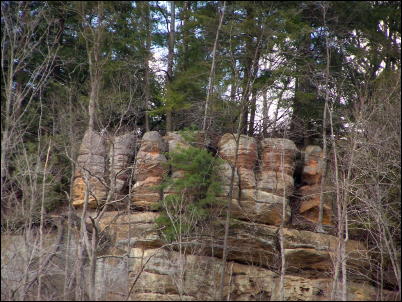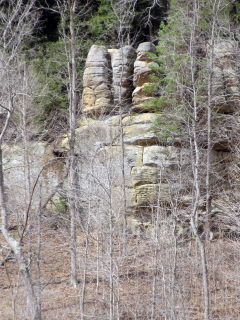2025 IDENTIFIED: MYSTICAL SEVEN ROCK PILLARS REST HIGH ABOVE CALHOUN RIVER - Magnificent Natural Creations Or Human Made Cairns?

Rocks above the West Fork, round pillars worn by the centuries or are they man-made cairns?
MYSTICAL ANCIENT PILLARS IDENTIFIED AS GEOLOGICAL FEATURES UNUSUAL FOR WEST VIRGINIA
By Bob Weaver March 2025
Original Story
Resting high on the mountain above the West Fork of the Little Kanawha River, between Rocksdale and Richardson at the long-gone village of Hassig, is perhaps one of the most unusual rock formations in Calhoun County, first photographing the formations about 30 years ago. They are not always visible from the road, often concealed by trees and vegetation.
Seven formations are almost touching the other, each pillar about 11 feet tall, each composed of what appears to be layered rocks, somewhat tubular.
They could have been carved and created my mother nature a million years ago, or they are made-cairns placed there by Native Americans with a symbolic purpose.
 The seven formations rests on a large boulder high above river
The seven formations rests on a large boulder high above river
UPDATE: WEST FORK OF LK RIVER MYSTICAL ANCIENT PILLARS IDENTIFIED AS GEOLOGICAL FEATURES UNUSUAL FOR WEST VIRGINIA
Bob Weaver March 2025
The mystery of the seven pillar rocks above the West Fork of the Little Kanawha River (Rocksdale-Richardson) are no longer a mystery.
"The pillars are not archaeological (man made cairns)" according to Lora A. Lamarre-DeMott, Senior Archaeologist, State Historic Preservation Office," referring the Hur Herald inquiry to Elizabeth Rhenberg, a geologist from the WV Geological Survey.
"It sounds like Calhoun County is home to some rock formations that are similar to those in Monument Valley out west," not in West Virginia. "That's pretty exciting!" said Lamarre-DeMott.
Elizabeth Rhenberg, a geologist from the WV Geological Survey:
"Thank you for forwarding this, it's been of great interest to those who've seen it. No one here at the Survey knew that this feature existed and think it's quite cool," said Rhenberg.
"It is not archeological in nature, but geological. The rocks are going through what we call "differential erosion." This means that there are some parts of the rock that are just more susceptible to eroding away than others. At some point in time, these rocks cracked (probably during the formation of the Appalachian Mountains) and those cracks have allowed for water and ice to eat away at the material inside, making the cracks ever bigger." "Beartown State Park is another example of this, only much more extreme. If you go out west to somewhere like Monument Valley in Arizona and Utah, that's an even more extreme example."
"Why did the rocks crack like they did? Who knows. Mother nature is always doing things that seem to have no real rhyme or reason. The ledge below the pillars is more resistant, which is why the cracks didn't continue through. Over time, those pillars will become more pillar-like and create an even neater feature for the area," concluded Rhernburg.
The rock structures will further be examined.